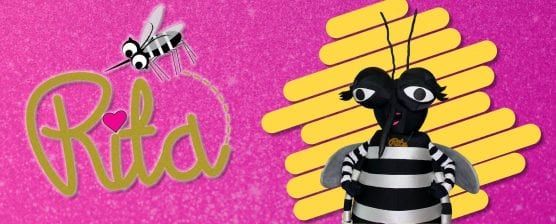To kick off California Mosquito Awareness Week and the mosquito season, the Greater Los Angeles County Vector Control District or GLACVCD has unveiled its new mascot, Rita the Mosquita.
The black and white striped Aedes mosquito made her debut on the district’s social media platforms on Monday, April 20, as GLACVCD joins other public health agencies statewide marking California Mosquito Awareness Week from April 19-25.
While COVID-19 is not transmitted by mosquitoes, the increased attention on public health is an excellent reminder that there are many ways for residents to protect themselves from other viruses transmitted by infected mosquitoes.
Visit the district’s social media pages daily on Facebook, Twitter, and Instagram during California Mosquito Awareness Week to answer mosquito-related questions. One participant will be randomly selected each day for the distinguished Citizen Excellence Award.
To join in on the fun, participants must reside or work in the district’s service area and must follow or like the district’s social media pages.
“Rita the Mosquita depicts the invasive Aedes mosquito that has been detected in Los Angeles County since 2011,” said Mary-Joy Coburn, director of Community Affairs at GLACVCD. “Her presence is a fun way to educate residents about a not-so-fun fact: these aggressive day-biting mosquitoes can make us sick, so residents need to take action now to protect themselves from mosquito bites and diseases they can potentially transmit.”
Rita is the offspring of Velma, the original mosquito mascot in the Region. Velma has been visiting communities and laying her eggs in stagnant water sources throughout the county. You can follow her journey here: Velma’s Surprise.
The Aedes aegypti and Aedes albopictus mosquitoes are two invasive mosquito species detected in 108 of the 156 cities and neighborhoods across GLACVCD’s service area. They are capable of transmitting debilitating viruses such as Zika, chikungunya, and dengue fever. These viruses are not currently being transmitted by mosquitoes locally in Los Angeles County.

Another mosquito-borne illness is West Nile virus, transmitted by the native Culex quinquefasciatus mosquito, which is endemic in the Southland. West Nile virus is transmitted to humans via the bite of infected mosquitoes, which become infected when feeding on birds carrying the virus.
There is no human vaccine for West Nile virus which can cause debilitating cases of meningitis, encephalitis, and even death. Currently, there are no reported birds with West Nile virus, or confirmed cases of human infections in Los Angeles County.
After a rainy spring, there are many areas of stagnant water, which can create mosquito breeding sites. Mosquitoes can lay their eggs in sources of water as small as a bottle cap and can complete their life cycle, from egg to adult, in about a week.
While staying home, residents can help reduce the mosquito population in their neighborhoods and communities by taking the following steps:
* Eliminate standing water in clogged rain gutters, rain barrels, discarded tires, buckets, watering troughs or anything that holds water for more than five days.
* Ensure that swimming pools, spas, and ponds are properly maintained.
* Change the water in pet dishes, birdbaths and other small containers daily.
* Wear EPA-recommended insect repellent when outdoors where mosquitoes may be present.
Like this:
Like Loading...
Related





 Tweet This
Tweet This Facebook
Facebook Digg This
Digg This Bookmark
Bookmark Stumble
Stumble RSS
RSS




























REAL NAMES ONLY: All posters must use their real individual or business name. This applies equally to Twitter account holders who use a nickname.
0 Comments
You can be the first one to leave a comment.